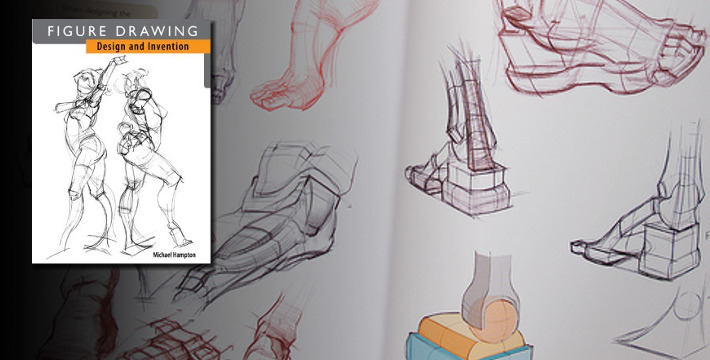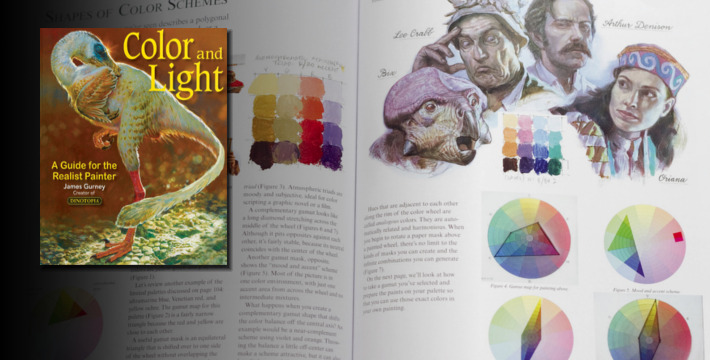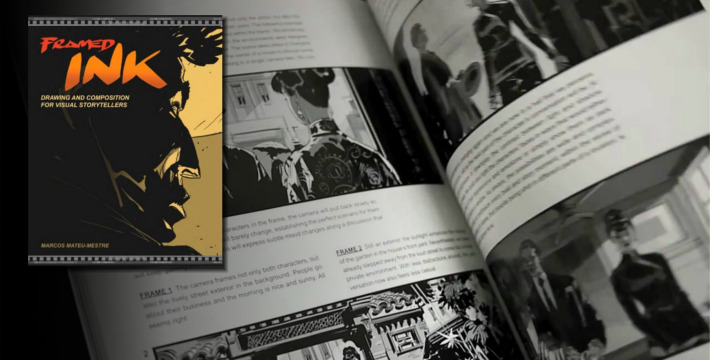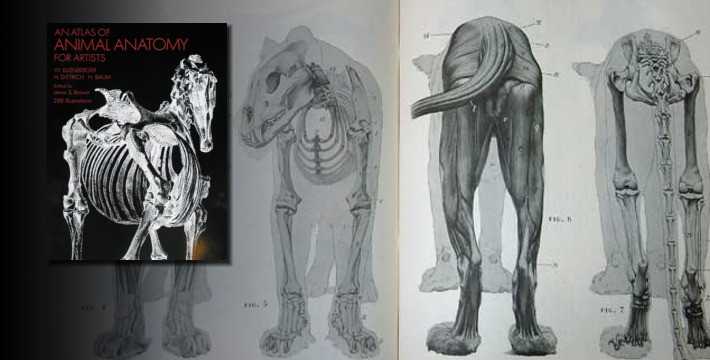Books I recommend
I bought many books over the last decade, and I wanted to share a small list of my top 5. Those books are not directly about "digital painting", but they learn the core.
Note: 'Reading' a guide will not increase your skill. You'll need to study, copy examples, and draw a lot to 'get it'. Studying a good book can take months... or years!
1. Figure Drawing: Design and Invention
by Michael Hampton, 240 pages
This one I discovered last year. Before this one, I learned mostly with the anatomies methods of George Bridgman, and Burne Hogarth ( I have all their books ). But training with this book made the real impact on my skill ; really clean geometric break-down, simple explanations of every parts. Link : http://amzn.com/0615272819

2. The Artist's Complete Guide to Facial Expression
by Gary Faigin, 288 pages
I appreciate this large book about facial expression mostly for the first part ; a complete guide for the anatomy of the face, with really interesting comments and tips to build the main features. Main part of the book about the expression is complex and really goes deep. For sure, I still only scratched the surface of studying this one properly. Link : http://amzn.com/0823004325

3. Color and Light: A Guide for the Realist Painter
by James Gurney, 224 pages
All or almost about color theory, in details, and also about shading. The reference about 2D rendering in my opinion. A book made for traditional painter, but easily understood by digital painter. Link : http://amzn.com/0740797719

4. Framed Ink: Drawing and Composition for Visual Storytellers
by Marcos Mateu-Mestre, 128 pages
A guide about image composition, but also about how to play with the eyes of your audience to tell your story. All in black and white, with a 'speed' style , the author draw a lot of examples and attract eyes on a wide variety of effect. A must have if you practise storyboarding, storytelling or comics. Link : http://amzn.com/1933492953

5. Atlas of Animal Anatomy for Artists
by W. Ellenberger, H. BAUM, H. DITTRICH, 151 pages
Not really a guide, or tutorial; but pages of raw black and white fine drawing of animal's anatomies. Horse, cat, dog, goats, etc...etc... most popular species are gathered on this thin book. Rich view angle ( front, side etc...) and often muscular view, and bone view. A very good reference if you have to illustrate horses ( like on my 12 books of "Le Club des chevaux magiques" ) or if you like to do creature design in general and need to know how some part of them 'work'. Link : http://amzn.com/0486200825

And you , what's your favorite art book ?
Feel free to share the title+author on the comments and discuss about it.
Note : this article contain visual copyrighted and can't be licensed under a creative commons license.


29 comments
I have all of them a part the last one. I remember when I was one of the few to know about Michael Hampton while now is suggeted everywhere.
When I search for a book I look on amazon a subject and I filter by the average of votes. Then I just look at the negative reviews. Because if something has good reviews you can't be sure that is really good. But if it has many negative reviews you can be sure it's not worth, though I need to read them because some people give negative reviews for things that are not related with the content. Then when I find a good book I check the books suggested by amazon and that were bought by the same people that got that book. Then I make a list of all the books and using Google I search for other reviews. All this work just to not buy a chris hart book...
i would add as authors Michael D. Mattesi, scott mccloud and the vanishing point by jason chheseman
@Marco : Good tip to find book on Amazon. Thanks to share your best reads, I have all about Scott Mcloud, and it's really good ( but too comic specific for my top5 ) but I don't knew the one of Michael D. Mattesi, nor Jason Cheeseman-Meyer. I'll add easy link here under at the end of my reply. I saw the preview of Christopher Hart's book ; yes, it doesn't look serious. Here I get disapointed by my purchase of 2 Tom Bancroft books. Books are good, there is honnest tips in it ; just the audience target is more for beginner than I thought. So, not for pro artist, more for large audience. I would advice them as complimentary books for teenagers or young art student.
✰ Understanding Comics: The Invisible Art
... and Reinventing Comics: How Imagination and Technology Are Revolutionizing an Art Form
by Scott Mcloud , both more than 230 pages, b&w
Link : http://amzn.com/006097625X and http://amzn.com/0060953500
✰ Vanishing Point: Perspective for Comics from the Ground Up
by Jason Cheeseman-Meyer, 128 pages
Link: http://amzn.com/1581809549
✰ Force: Dynamic Life Drawing for Animators
by Mike Mattesi, 248 pages
Link : http://amzn.com/0240808452
I have all these books on my amazon wishlist and gladly already bought "Color and Light: A Guide for the Realist Painter".
My other favorite books are:
Imaginative Realism: How to Paint What Doesn't Exist by James Gurney
http://tinyurl.com/plkkn6y
Four Jack Hamm Books:
Drawing the Head and Figure
http://tinyurl.com/p5l6uef
Drawing Scenery: Landscapes and Seascapes
http://tinyurl.com/q8zts43
Cartooning the Head and Figure
http://tinyurl.com/nqne45l
How to Draw Animals
http://tinyurl.com/p8jfh6q
And if you feel burned out and lost some fun with drawing, I can recommend very sweet books by Carla Sonheim:
Drawing and Painting Imaginary Animals: A Mixed-Media Workshop with Carla Sonheim
http://tinyurl.com/pvucdne
The Art of Silliness: A Creativity Book for Everyone
http://tinyurl.com/nf54y9r
For months I'm also waiting for:
How to Draw: drawing and sketching objects and environments from your imagination by Scott Robertson
http://tinyurl.com/nwaeloo
Can't wait to have this treasure on my desk :).
Thanks for sharing your favorite art books. Going to buy "The Artist's Complete Guide to Facial Expression", immediately.
Upps,I messed up the formatting..
Screenwriter Book:
The Screenwriter's Problem Solver:
http://www.amazon.com/gp/product/0440504910
Memo from the Story Department:
http://www.amazon.com/gp/product/1932907971
These books,also suitable for comics author.
I feel very practical two books.
@Sylvia Ritter : Thanks for sharing your ref, and no problem about the formatting, it's great to have your links. Scott Robertson's book looks a very good one about constructive design. I'll probably purchase it soon.
@Senlin : Oh cool ; books about storytelling / scenarios. Nice ! thx for sharing .
thank you for this books, but maybe you could gave advice for initial artist?
P.S.Sorry for my English.
@Anton : For total beginner ; I would advice
✰ Successful Drawing
by Andrew Loomis
About drawing , and core technics : free download of the PDF here :
http://www.alexhays.com/loomis/Andrew%20Loomis%20-%20Successful%20Drawing.pdf
✰ Chaos & Evolutions
by me :-P ( not a book, a DVD video )
About digital painting basics : free viewing on Youtube :
http://www.davidrevoy.com/article172/chaosevolution-digital-painting-1h30-open-tutorial
Also, check the Concept Cookie website , and Ctrl+Paint website. Have fun !
thank you very much! :)
This is a collection of Craig Mullins posts on sijun forums:
http://filesmelt.com/dl/CraigMullinsSijunPosts.pdf (the download takes a while before starting)
It's not a book, but it's very interesting.
Figure drawing est vraiment impressionnant !! Ca faisait longtemps que je cherchais un bouquin d'anat comme ca.
C'est exactement ce qu'il me faut pour me perfectionner.
Un grand merci !
For the slightly more experienced artist interested in learning how to paint impressionistic semi-abstract pictures, I found Realistic Abstracts by Kees Van Aalst to be a brilliant book. It's full of inspirational ideas and the simplicity of many of the studies makes it relatively easy for a newer artist to learn from.
hi,
do you totally recommend "chaos & evolutions" with have no experience with draw traditional ?
thanks!
@microname : Chaos&Evolutions is now online ( youtube video ) for free, check the tutorial category on my blog to find it.
There is a problem with "no experience with draw traditional" ; because it's at the root of everything. It's like if you don't know how to write, but want to use LibreOffice. A minimal understanding of volumes, proportions, and shading is required. Thanks!
J'ai découvert depuis quelques mois ton site et ton blog, et je lis tes articles avec un réel plaisir. J'apprécie la qualité de tes dessins, ton penchant à partager et à démontrer que l'on peut travailler avec des outils libres.
Dans ta liste, j'ai acheté "Figure Drawing: Design and Invention" qui est vraiment excellent. C'est exactement ce que je cherchais pour le dessin de personnage. A compléter avec un livre plus orienté sur l'anatomie pour les perfectionnistes.
Une remarque, ton top 5 contient exclusivement des livres en anglais. Et pas un seul n'est traduit en français. Rien d'alarmant pour moi, je gère, mais aurais-tu une liste pour des lecteurs non-anglophones ?
@Guillaume : Merci pour ton retour Guillaume! En français, c'est vrai que j'ai pas grand chose. Principalement des ouvrages ( superbes ) sur la BD :
Scott McCloud : ( une traduction, mais bien faite )
- L'art Invisible
- Faire de la BD
Duc
- L'art de la BD ( tome 1 et tome 2 ) , Glénat
Je me ballade souvent dans les Cultura, Fnac Livre, etc... pour voir les ouvrages Art traduit en FR, mais ce sont souvent des 'objets cadeaux' plus que des livres utiles. Des sortes de grand livre couleurs avec plus de mise en page que de contenu. Pas facile de trouver des ouvrages techniques de qualité sur le dessin figuratif.
Hello,
I'd strongly recommend:
"Die Gestalt des Menschen" by Gottfried Bammes
The english title would be "The Artists Guide to Human Anatomy", although I'm not sure if they didn't delete some nude photographs from the original book and it's much shorter, too: only 144 pages compared to the german original with 506 pages!!!. This book is THE definit anatomy guide, going into every detail about skeleton, muscles, lipides, facial expressions, movement, deformation of muscles when in use, etc. etc.
And also "How to Draw" and "How to Render" from Scott Robertson.
It's more about industrial design, but very thorough and helpful, also for organics ;)
More of a philosophical aspect offers: "Drawn to Life" from Walt Stanchfield. It's about the essence of living drawings/paintings. When you read this book(s), you'll see all those more design-like drawings different :) You'll get a feeling for "real, living" drawings and paintings. It offers a lot of tipps and tricks which might seem obvious, but after comparing the students works with the masters corrections, you'll see, there's more to it than you think.
Live long and prosper.
What I and many others consider the definitive book on inking: "Rendering in Pen and Ink: The Classic Book on Pen and Ink Techniques......." Written over 60 years ago by Arthur L Guptill. 256 pages of pen and ink techniques that can just as easily be applied to the digital age.
A long-time favorite of mine is Kimon Nicolaides' "The Natural Way to Draw." It is a book/training course purely on drawing; no color theory is mentioned until the final section ... pure chiaroscuro.
My copy of Guptill's book (mentioned above) was handed down from my father, another of my treasures.
I keep going back to "Figure Drawing without a Model" by Ron Tiner. He covers the usual stuff about anatomy. What's different for me is that he touches on ethnic differences and fat distribution. My favorite part is his discussion on practical composition.
Exclusive and awesome collection!! Thanks for sharing.
Je suis encore débutant, mais un livre que je recommanderais : Dessiner grâce au cerveau droit, de Betty Edwards.
Le livre parle de techniques, mais surtout de notre perception visuelle et explique la difficulté que tlm peut avoir a dessiner et pourquoi, perso j'ai adoré :) c'est une source de motivation!
@Talrascha : Ha oui, j'en ai entendu parlé une fois dans une réunion Blender à Toulouse. Ce livre à l'air vraiment sympa. Je vais me le procurer. Merci pour le retour!
Hey David, really i'm glad to see you books i recommend for learning to draw and paint.
This is really a old blog post but also timeless.
for me as a beginner, its very hard to find the right starting point for my art journey. On the one side its hard to accept to take a step back and really start with the very basics. On the other hand, its alredy hard to figure out what the "very basics" are. For example: Many "learning" books on drawing, didnt give a "overview" of the learning steps you have to pass to be really self-determined in art. They just offer something to copy. I waste so much time with that, unbelievable. On the other hand you find fast recommend books like figure drawing from loomis, but as a beginner you open the book and the information are so overwhelming because you dont have the fundamentals to study it. I always feel alone with this problem, dont know if its because the most artists have art in middle school or family members who can recommend a jump start.
Thanks for the recommendation of "Successfull drawing". This is the very first book, i feel really comfortable with and i know how to study it. What me also really helps was the overview of learning by Clint Cearley:
https://www.youtube.com/watch?v=ni4ts22XFsw
Hey, yes it is very a hard and a long process (at least for me). I'm still reading Loomis and it has many layers of learning and I am still amazed by all the things I still have to learn. I spent a part of october understanding neck and shoulder. Good video, thanks for sharing.
Bonjour David !
Je viens de te découvrir via les illustrations que tu as confectionné pour Framasoft :)
Je souhaiterai apprendre à dessiner des illustrations "simples" de ce type : https://frama.link/E35K4U90
Aurais-tu des ressources à me conseiller ? (je suis un grand débutant).
Merci !! :)
Bonjour! Merci!
Le rendu de ce genre de dessin est vectoriel. L'outil en corespondant en logiciel libre, c'est Inkscape. Il y a plein de tutoriel et de timelapse sur les plateformes vidéos pour maitriser ce type de tracé: https://duckduckgo.com/?t=canonical&q=drawing+with+inkscape&iax=videos&ia=videos
Here's an odd rec; strictly speaking, not an art book. But it gives a strong visual and volumes-based understanding of anatomy, botany, architecture, rocks, cloth, boats, other machines, etc.; basically anything material.
J.E. Gordon's popular science books on structures. As an engineer, the he looks at structures in a completely different way from an artist, but he explains visually, with lots of little line diagrams. He teaches how to see everything like an engineer, not just centers of gravity but thrust lines and deflections and where wrinkles will form and why. He literally covers everything from cathedrals to military helicopters to fashion design. He also has a sense of humour.
Particularly useful if you want to draw convincing physical images of imaginary things, and thus can't draw from life or a photo. Side effects include glancing at artworks and crying "But that wouldn't work! Because..." instead of just getting a vague feeling that something-or-other is unconvincing.
Not to contradict our host, but copying examples would be useless for this one. Read, think, and then stare at everything around you with new eyes.
The New Science of Strong Materials: Or Why You Don't Fall Through the Floor - Pelican Books, 1968 - ISBN 0-691-02380-8
Structures: Or Why Things Don't Fall Down - Pelican Books, 1978 - ISBN 0-306-81283-5
I warn against some of the 20th-cen reprintings; one I saw had the plates printed on the regular page paper, not only at a resolution too low to see some of the features which were being illustrated, but with artifacts striped diagonally across them!
Post a reply
The comments on this article are archived and unfortunately not yet connected to a dedicated post on Mastodon. Feel free to continue the discussion on the social media of your choice. Link to this post:You can also quote my account so I'll get a notification.
(eg. @davidrevoy@framapiaf.org on my Mastodon profile.)